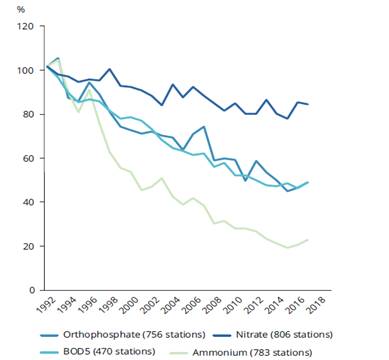Post a comment on the text below
Impacts
Impacts from point source pollution to waters are caused by oxygen consuming substances, like ammonium or other substances, indicated by the measurement of the biochemical oxygen demand (BOD), nutrients such as phosphorus and nitrogen, hazardous substances, emerging pollutants, pathogens, like bacteria, viruses, or parasites, and microplastic particles.
The BOD shows how much dissolved oxygen is needed for microorganisms to decompose the organic matter. The resulting oxygen deficit in highly organic polluted waters causes impacts on aquatic communities, e.g. the loss of several macroinvertebrates and acute toxic impacts on fish.
Overall, concentrations of oxygen consuming substances (BOD, ammonium) and nutrients (nitrate and phosphate) have decreased over the last 25 years (Figure 3). It needs to be mentioned, that nitrate as well as phosphorus in rivers is not solely attributable to point sources of pollution. Those substances can also be released from diffuse sources.
Figure 3 Trends in biochemical oxygen demand (BOD), ammonium, orthophosphate and nitrates in rivers

Notes: Insert notes here
Source: (EEA 2019b)
Hazardous substances are defined as toxic, persistent, and liable to bio-accumulate (Article 2, WFD). Some of the priority substances listed in Annex X of the WFD are defined as hazardous, for which all discharges, emissions and losses must be ceased within 20 years after adoption of cessation proposals by the European Parliament and the Council (WFD, Art. 16 (6)). Those substances are for example 4-Nonylphenol (surfactant) or pBDEs (flame retardants) used in many industrial productions. Beside the risk of hazardous substances, emerging pollutants are present in low concentrations and include inter alia pharmaceuticals and personal care products, chemical degradation products, or endocrine‑disrupting compounds. The knowledge of long-term effects of these pollutants as well as the cocktail effect in waters is rather unknown (EEA 2018a).
You cannot post comments to this consultation because you are not authenticated. Please log in.


